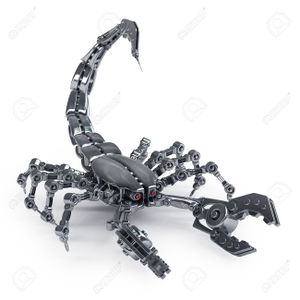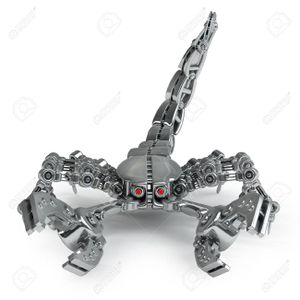There are multiple variants of this technology, please refer to Drone Disambiguation for a list of the variants. |


The Mark 1S is one of the initial models of automated repair systems. The drones are designed to be autonomous and conduct both scheduled and impromptu maintenance at the behest of a central controlling computer. With the use of AI's to control primary systems on Solas Tempus facilities / vessels the Master Systems AI would be in charge of coordinating automated repair and maintenance strategies for a vessel.
- Power Source
- Spatial Variance Reactor
- Size
- 31.5 mm Long (Body Only)
63.8 mm (Body Including Tail)
29.9 mm (Leg)
32.2 mm (Claw & Arm) - Propulsion
- 8-Legged Ambulation
- Average Speed
- 11 kph
- Maximum Speed
- 48 kph
- Jump Height
- 36 cm
Construction
The outer shell of the Mark 1S is a duranium / nanomaterial composite which allows the drone to reorganize its protective shell to be more resistant to harsh environments that otherwise cannot be entered. The interior is made of a tritanium / nanomaterial composite for the primary structural components.
Systems
The Mark 1S is designed to automated deployment within a vessel to move into places which are too hazardous or too time consuming to allow conventional repairs and maintenance. Their physical 8-legged design allows them maximum stability. Their "feet" can be altered with nanomaterials they are able to use conventional magnetic locking to attach to and walk on walls, ceilings, and other services. They are also capable of attaching themselves to other services using different modes depending on what their feet and legs need to do at the time.
Computer
The main controlling computer is a positronic computer core with a large internal memory capacity and simple processing. The primary directives a single drone has instruct it to seek out malfunctions according to the specifications in its database and attempt to repair them autonomously once deployed. So long as there is a controlling AI or other central authority the drones will not self-deploy unless directed to.
Sentience
A single drone is intelligent in that it can gather and apply knowledge but is unable to think abstractly. It is also not self aware, only achieving a level 2 of self awareness. As a group, the collective intelligence achieves a maximum of a level 3 of self awareness. Neither individually nor as a group do they possess consciousness.
Communication
The computer core is directly linked into BlueNet as it's primary means of communication using short-range subspace channels. These channels operate in two distinct modes which are not mutually exclusive. The primary operating mode is connected to a central computer authority, usually a Master Systems AI but could also be a HAL node or other advanced computer core. The secondary operating mode is in a mesh network forming a collective intelligence.
Sensors
The drone has two primary focused sensors which detect the entire EM spectrum from low energy long-wave radio to ultra high energy gamma rays. These two sensors have a particularly narrow field of focus, the main body has a sensor array along the spine up along the tail which has a less focused and broad sensor capability which allows detecting subspace as well as EM fields. The body itself can detect vibrations and movement to
Tools
Using nanomaterials and nanites similar to those used in the Class 3M Armor the drone is able to reconfigure its skin, feet, and claws to fit a variety of tasks. It is able reconfigure itself in these extremities to suit a variety of needs and conduct repairs. The drone is equipped with a Replicative Repair Beam in the tail which works in conjunction with other tools to effect repairs, replacing damaged components with working ones, recycling damaged or unusable materials.
Deployment
The Mark 1S can be deployed in a three ways, though it is designed to deployed in a directed way where they are given general orders and monitored but allowed to proceed with those orders at their own discretion.
Directed
The normal method of deployment is directed. An AI or other computer system directs the deployment, objectives, priorities, and sometimes even methods for the drones to operate. In this method the drones are only allowed as much autonomy as the controlling system requires, though they are most effective when able to utilize their problem solving and autonomous organizational capabilities.
Undirected
If left undirected the drones first determine what kind of facility they are in, they do this through either communication with a central computer which directs them as to the specifications and design of a facility or through direct observation. They have the ability to recognize construction hallmarks for any structure for which they have schematics and will seek to identify and confirm this themselves.
Once they have identified the specifications in use, they will begin to seek out and repair any device not operating within specified norms according to their specifications. They are able to learn and do limited problem solving and pattern recognition, such as learning a starship has one type of part in use instead of what type of part falls within specifications and extrapolate on what they might do to specifications they have on file. If they cannot autonomously repair something or are unable to make suitable repairs system-wide they will attempt to find the most optimal operating specifications available using the specified norms as a guide.
However the drone establishes the norms for the facility it has been deployed in, the drone will place an automatic priority on the following systems:
- Destruction Prevention
- Survival of the ship if imminent threat of destruction is detected.
- Life Support
- Survival of crew, this can be placed at a higher priority to preventing destruction in some circumstances.
- Power Systems
- Repairing systems is easier with a reliable power supply.
- Central Computer
- Since the drones operate best when able to communicate with the central computer, they will attempt to repair the ships central computer first unless directed otherwise.
Drones being undirected by a computer can accept simple verbal commands to focus repairs on a particular system either by the name of that system or by being directly shown visually to repair a specific component. This is not as effective as the drones only accept simple verbal commands and do not understand nuance.
Unfamiliar Territory
If drones are deployed within an unfamiliar setting their effective nature drops significantly. While collectively they are able to establish norms of operation, and build maps and specifications of a structure they have no way to intelligently determine if what they see is what they are supposed to see. They can, however, determine function of most parts being used and ensure those parts are operating within specifications. That is to say they can see a plasma relay and understand it is a plasma relay. They can see a system which uses the relays would require a certain output range to be functional and thus adjust their expectations of the individual parts. In this way they can adaptively learn the specifications of an unknown structure within a certain degree of accuracy.
Reaction
Initial testing of this device was done within the mindset of functionality instead of appeal or aesthetics. While the development team was fond of the aesthetics many engineers who have been involved in testing found the devices to be especially creepy or vaguely threatening. While the design was seen as solid by testing groups and proven to be effective in a variety of situations, it was decided that the devices would be programmed to avoid people.
There was some controversy over this decision, stating that the devices should be left as is and people could get used to them. Other voices in the controversy site that the devices, in attempting to stay hidden, may appear even more ominous and less desirable. Ultimately the Master Systems AI on a given facility will have discussion over this behavior.
During meetings discussing the reaction to the drones, the lead researcher made a note that the devices were tools and not meant to be sociable and liked. In fact beyond working together they are specifically coded to not be sociable with people already. The additional directives were determined to be optional for a MSAI to implement or not.